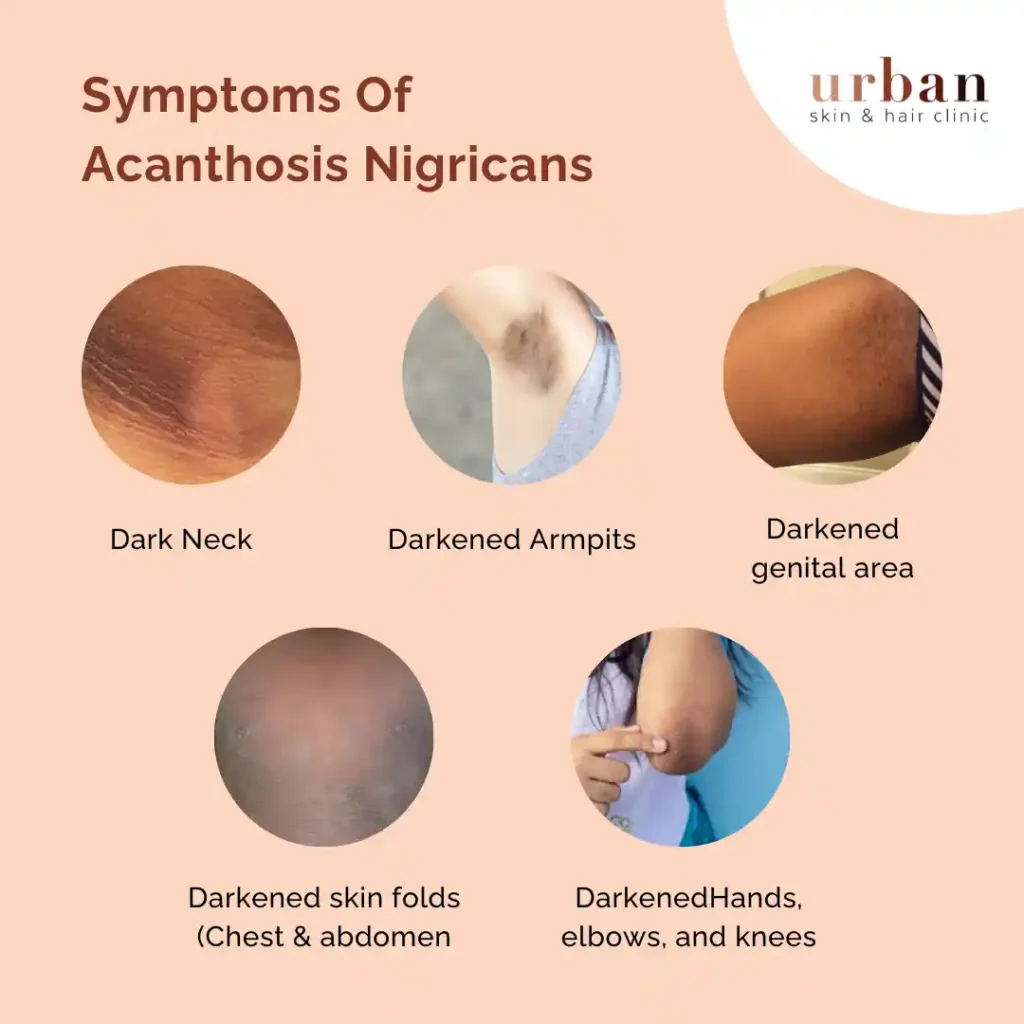
What is Pruritus?
Acanthosis nigricans is a dermatological condition characterized by dark, thickened, and velvety patches of skin. These patches typically appear in body folds and creases, such as the neck, armpits, groin, and sometimes under the breasts or around the navel. Less commonly, it can affect the hands, elbows, knees, or face.
What are the causes Of Acanthosis Nigricans?
Acanthosis nigricans (AN) is primarily caused by insulin resistance, a condition in which the body’s cells do not respond effectively to insulin. When the cells become resistant to insulin, the pancreas compensates by producing more insulin, leading to elevated insulin levels in the bloodstream. This excess insulin can stimulate the growth and multiplication of skin cells and melanocytes (cells responsible for producing melanin, the skin pigment), leading to the characteristic darkening and thickening of the affected skin areas.
- Obesity: Obesity is one of the leading risk factors for AN. Excess body weight is often associated with insulin resistance, making obese individuals more susceptible to developing this skin condition.
- Diabetes: A significant number of individuals with type 2 diabetes also experience AN. The insulin resistance present in diabetes contributes to the skin changes.
- Hormonal Disorders: Conditions such as polycystic ovary syndrome (PCOS), Cushing’s syndrome, and disorders affecting the adrenal glands can lead to hormonal imbalances that trigger AN.
- Genetic Predisposition: Some people may have a genetic predisposition to developing acanthosis nigricans, particularly if other family members have experienced the condition.
- Certain Medications: Some medications, such as oral contraceptives, corticosteroids, and growth hormones, can cause drug-induced AN as a side effect.
- Insulinoma: In rare cases, AN may be caused by insulin-producing tumors in the pancreas called insulinomas, which lead to excessive insulin secretion.
- Other Medical Conditions: AN can also be associated with various medical conditions, including metabolic syndrome, thyroid disorders, and certain cancers (e.g., stomach cancer).

What are the Types of Acanthosis Nigricans?
- Benign or idiopathic AN: This is the most common type of AN, where the condition occurs without any underlying health issues. It is usually considered harmless and often associated with obesity. Weight loss and lifestyle changes can help improve this type of AN.
- AN associated with insulin resistance and diabetes: This type is linked to insulin resistance, which is a precursor to type 2 diabetes. It is often seen in individuals with obesity and metabolic syndrome. The skin changes in these cases are more extensive and can be more difficult to treat without addressing the underlying insulin resistance.
- AN associated with hormonal disorders: Acanthosis nigricans can be related to various hormonal disorders, such as polycystic ovary syndrome (PCOS) and disorders of the adrenal glands. In these cases, managing the hormonal imbalances is essential to improve the skin condition.
- Malignant AN: This is a rare form of AN that is associated with certain cancers, most commonly stomach (gastric) cancer. Malignant AN tends to appear suddenly and may be more severe. It is crucial to investigate the underlying cause and treat the cancer to manage this type of AN.
- Drug-induced AN: Some medications can lead to the development of acanthosis nigricans as a side effect. Medications like oral contraceptives, corticosteroids, and certain growth hormones have been associated with drug-induced AN. Discontinuing or changing the medication may help resolve the skin changes in such cases.
- Syndromic AN: Acanthosis nigricans can be associated with certain genetic syndromes, like the syndrome associated with mutations in the FGFR3 gene. In these cases, the AN is part of a broader syndrome and is typically seen from an early age.

Signs & Symptoms of Acanthosis Nigricans
The primary symptom of acanthosis nigricans (AN) is the appearance of dark, thickened, and velvety patches of skin in certain areas of the body.
- Neck: Dark and velvety patches may appear on the back and sides of the neck.
- Armpits: AN can affect the armpits, leading to darkened and thickened skin in this area.
- Groin: The skin in the groin region, including the inner thighs and genital area, may show signs of AN.
- Chest and abdomen: In some cases, AN can also occur on the chest and abdomen, particularly in skin folds
- Hands, elbows, and knees: Though less common, AN may appear on the knuckles, elbows, and knees in some individuals.
The affected areas may vary in size and can range from tan to dark brown or black in color. The patches can gradually increase in size and may become more pronounced over time.
Treatment Of Acanthosis Nigricans
The treatment of acanthosis nigricans (AN) involves addressing the underlying cause, as it is a symptom rather than a disease itself. The primary goal of treatment is to improve the appearance of the affected skin and manage any underlying health conditions contributing to AN. Here are the main approaches to managing acanthosis nigricans:
- Weight Loss: Achieving and maintaining a healthy weight through a balanced diet and regular exercise can help improve insulin sensitivity and reduce skin changes.
- Healthy Diet: A diet low in processed foods, sugars, and refined carbohydrates and high in fruits, vegetables, and lean proteins can aid in managing blood sugar levels and insulin resistance.
- Treatment of Underlying Conditions: If acanthosis nigricans is linked to an underlying medical condition, such as diabetes, polycystic ovary syndrome (PCOS), or hormonal disorders, managing these conditions with appropriate medical interventions can lead to improvement in the skin changes.
There are some topical treatments that can help improve the appearance of the affected skin:
- Retinoids: Topical retinoid creams or gels can help to exfoliate the skin, smoothen its texture, and reduce the dark patches.
- Alpha Hydroxy Acids (AHAs): Creams containing AHAs can help to exfoliate and lighten the affected skin.
- Urea Creams: These creams can help soften and moisturize the affected areas, leading to improvement in the skin’s appearance.
In some cases, cosmetic procedures may be considered to treat AN:
- Laser Therapy: Laser treatment can be used to reduce the thickness and pigmentation of the affected skin.
- Chemical Peels: Chemical peels involve the application of a chemical solution to the skin, which exfoliates the top layer and can help improve the appearance of AN.
It’s important to note that while topical treatments and cosmetic procedures can help improve the appearance of the skin, they do not address the underlying cause


